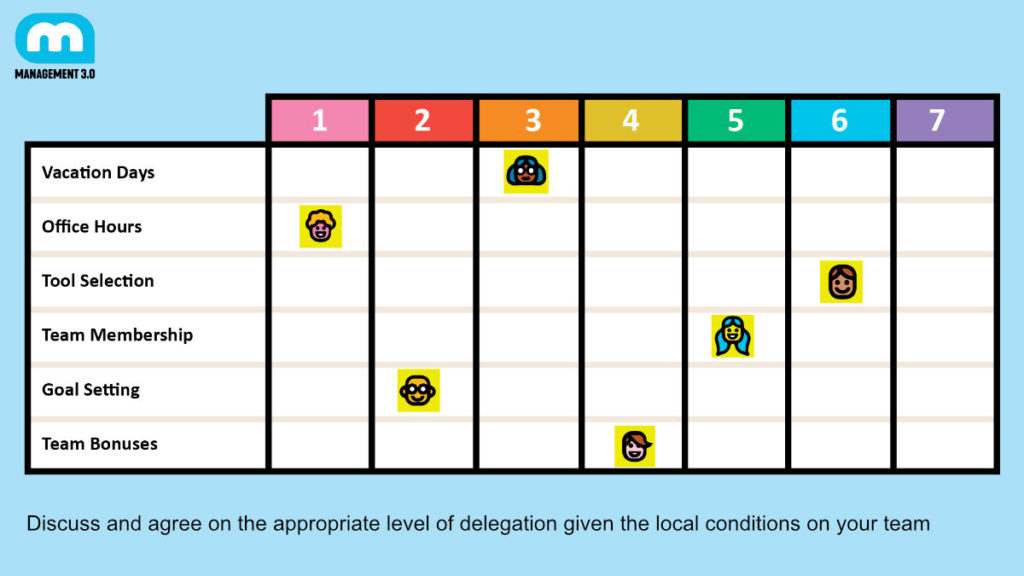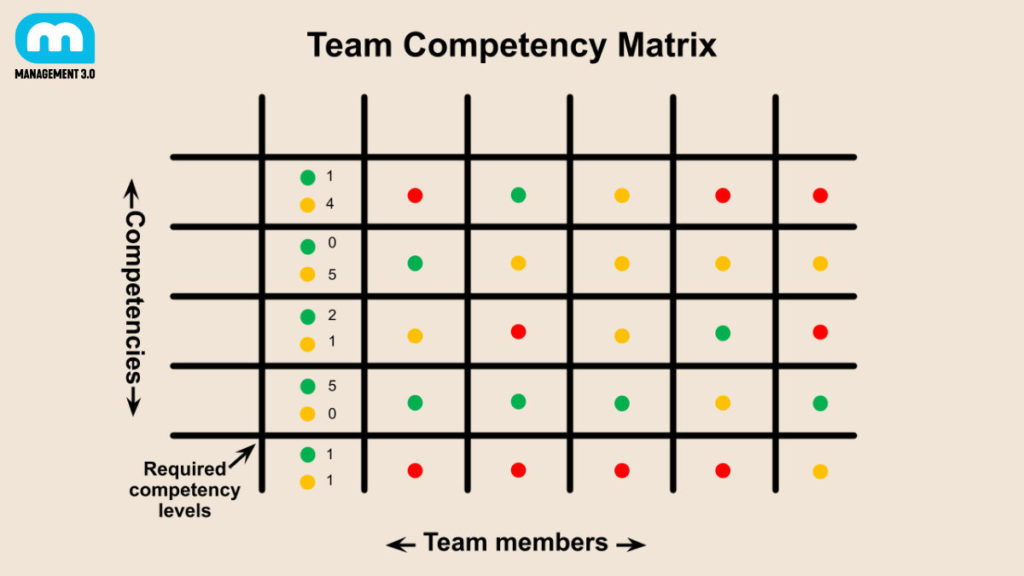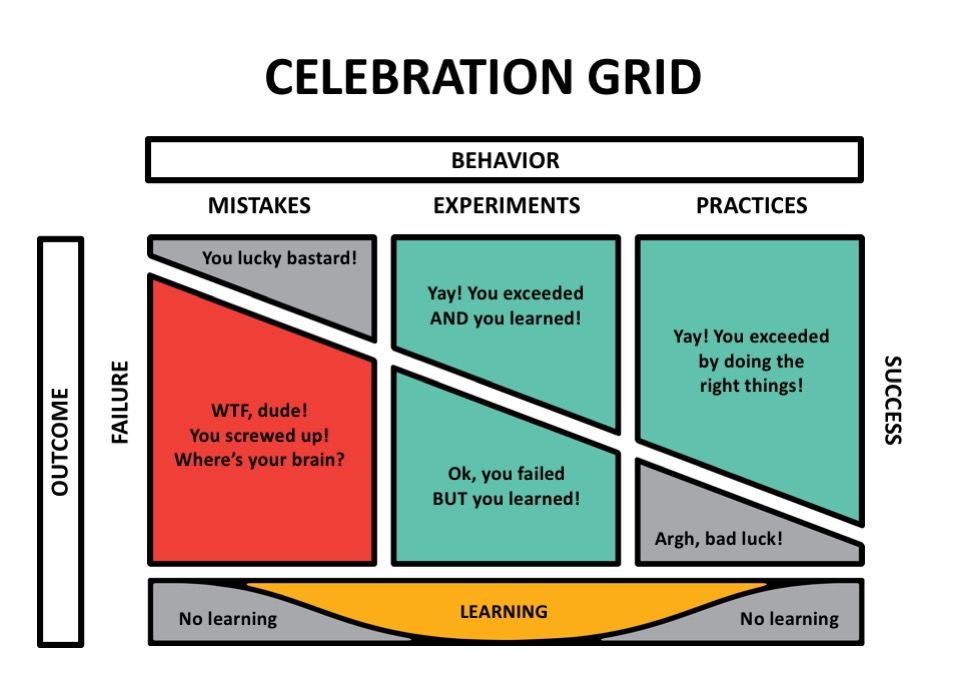An article by Management 3.0 Facilitator and business agility expert Andrea Darabos. She and her team at Lean Advantage work with purposeful organizations who believe in the power of people and self-management to realize big bold goals. And she knows much about “managing up”.
Note: this article is targeted at individuals working remotely in agile organizations and agile teams, mid managers aiming to cultivate trust, alignment and autonomy
Does your manager trust that you are really working?
Do you trust your manager?
I will admit, I (still) have trust issues. After seven amazing years at a global engineering company, I found myself leaving because I did not fully trust my manager. It took me years of reflection to realize that I had too high expectations of her. I expected her to be perfect – to motivate me, to give me regular feedback and to even manage my career. Besides, I failed to communicate with my manager about my needs or aspirations at work. Because I did not take responsibility for these things myself, I chose the easy way out – and left the company.
It took me another seven years to write this article and to look back with gratitude at my early managers (including her). If you too, recognize yourself in this story, I encourage you to read further, as we will explore how to “manage up” – i.e. cultivate a healthy trust-based relationship with your manager. So that if you do end up leaving your job, you leave for the right reasons. And perhaps you will stay and make your job better.
In this article, I will examine why it is important to manage your boss and how to develop and maintain a trusting relationship with them using Management 3.0 practices.
What does it mean to “manage up”?
First of all, let’s look at definitions.
Most organizations, no matter how much they have advanced on the self-managing spectrum, do have some form of structure which is defined by the decision-making authority distribution of various players. If this structure is a hierarchy, then “managing up” is defined as cultivating a trusting relationship upwards towards your supervisor(s) in the hierarchy.
If the structure of your organization is a self-managing network (e.g. holacracy, teal or similar) and there are no formal manager roles, then “managing up” is defined as cultivating trusting relationships and managing expectations on the boundaries of your decision making authority. This definition is inspired by the work of Daniel Mezick detailed in his book Inviting Leadership.
Managing up is especially relevant for self-organizing teams (squads or tribes) in agile organizations and for their mid managers (or chapter leads) – in order to cultivate an environment of empowered initiative and clarity. When working remotely, the boundaries of these self-organizing teams (including mission, goals, success metrics, authority rights) need to be regularly clarified, re-adjusted and re-aligned with the stakeholders of the team and communication needs to be planned more consciously.
According to this HBR article from 2020, many remote managers struggle to trust that their teams and subordinates are indeed working and delivering the expected outcomes in agreed quality. As trust is a quality of relationships, the other sign of the coin holds as well. Self-organizing teams and knowledge workers need to trust that their manager can be trusted, too – that the managers are indeed focused on creating optimal work conditions for them and are removing impediments.
“Managing up” prevents the team from experiencing excessive “Managing down”.
Mastering “managing up” should prevent your boss and other stakeholders from becoming concerned and to revert back to micromanagement behaviors – which would damage the self-organizing autonomy of your team. It also – as in my story – prevents you from being overly reliant on your manager to take responsibility for decisions that you should own and decide for yourself
How can you cultivate a trust-based “managing up” relationship with your boss and stakeholders?
Thankfully, we have plenty of Management3.0 practices and tools on managing (as a verb) – and these tools can be very well applied to both managing ourselves as well as managing our boss.
Below, I share seven tips to cultivate trust when managing your boss – especially when working remotely – Seven practical ways to manage your boss
#1 Tip to Manage your Boss: Communicate intent and measures of success
Before we can focus on your autonomy about how you work, it is important to ensure that we are working towards a clear outcome with defined success metrics – and we have defined these in alignment with our manager(s) intent.
In military organizations, they call this practice the Commander’s Intent – and it is about having clarity about the goals of the organization, of teams and individuals. This is essential so that decentralized decision-making and local action can happen without any delays. I often show the award winning navy captain David Marquet’s video on my trainings, which tells the story of managing by intent. Rather than only expecting managers (“from the top”) to communicate their intent, we should also “manage up” by communicating our intent to our managers and colleagues.
In conversations, we should spend about 80% time on clarifying our intent, and the remaining 20% on discussing the next action to take.
Once the intent and objectives are clarified, adding some metrics as a way to measuring progress and to help us learn makes sense. In the Management 3.0 toolbox, we have a useful set of guidelines about how to set and use success metrics and this can be implemented in practice by communicating and aligning on OKRs – Objectives Key Results:
- Each person and team should set an objective and describe the intended qualitative outcome they’d like to achieve in the next 6 weeks – 3 months
- Define around 3 Key Results – which are best leading indicators, metrics that would change in a positive direction once we implemented our first experiments and actions towards the defined objective
- Have conversations – an alignment period – with peers, managers and other teams, stakeholders who depend on or can contribute to the objective. These are the intent based conversations that help us align and also get started with first ideas to achieve the objective.
- Tie back every conversation to your defined OKRs – your daily standup meetings or team huddles, your sprint planning meetings, your demos and retrospectives – talk about your intended objectives and your recent experiments, lessons learned on the path to achieving them.
Anchoring daily Intent conversations and communicating objectives and success metrics transparently in my experience, can sky-rocket your autonomy and creativity across the organization. Ensuring that your own OKRs and actions help your managers achieve theirs is a great opportunity for “managing up” and creates a reason to learn, experiment together.
#2 Tip to “Manage Up”: Agree on how you will make decisions
Another way to gain more autonomy and speed for yourself and your team is to look at how decisions-making is distributed between you and your manager. Gaining real clarity on what decisions you have full authority to take without needing to consult or to wait for your manager is a great start. However, in my experience, most decisions are not delegated or not – but require a much more complex process of consulting and aligning experts, stakeholders, and contributors.
In Management 3.0, we have a practice called Delegation Boards to help you and your manager clarify your decision-making agreements in the most frequently occurring situations local to your role or local to your team. It is a fantastic tool that helps make the decision-making boundaries explicit and transparent.

- List your decision-making situations (e.g. hiring a new team member, spending money to buy equipment/resources/training, allocating work within the team etc)
- Print the Management 3.0 Delegation Poker Cards representing seven levels of delegation. You can buy it from our shop or use the Miro template
- Discuss expectations with your manager and other team members on how you think it would be best to make a specific decision. And don’t forget to go into detail.
- For example, when your decision making aim will be to reach an agreement (level 4 in Delegation Poker),- you may want to consider the options of making a decision based onconsent, consensus or majority vote (or some form of voting). The right approach will depend on your context and wanted outcomes – best is if you experiment.
- Once you have discussed the key decision-making situations that the team is expected to make decisions on more autonomously, it is also a good idea to list some situations where you would prefer more decision ownership from your manager (a true example of “Managing up”). Management 3.0 Facilitator Vivek Ganeshan calls this practice the Inverted Delegation Poker.
#3 Tip to Manage your Boss: Own your Competency and Learning Plan
This is a key area of “managing up” so as to ensure that you and your team have the right plan and resources (time, money) in place to support continuous learning. Besides, learning is not only valuable but it is also motivating and energizing. With the Team Competency Matrix, your team can visualize the continuous learning plan together with team members and learning sponsors (HR, Learning and Development, managers). Unlike traditional HR processes for yearly learning plan development, you can use the competency matrix continuously and keep it up to date as your team’s and individual objectives evolve.

In very simple steps, the process goes as follows:
- List all the current and needed competency areas for your team based on the team’s roadmap (looking ahead six months – one year from now) and your personal interests (what are you learning now/would you like to learn that might be useful in the future?)
- List all team member’s names in the columns
- Add a column before the first team member’s name in which you plan the target competency level for the team in your next learning cycle (eg. in six months, we would need to have at least one expert Python programmer and three practitioner Python programmers on our team – and the rest of the team novices)
- Ask each team member to rate their current level of competence against all the listed competencies
- Come up with a plan to address the gaps – defining learning experiments such as self-study, pair-working, hiring a mentor/coach, attending a training, hiring a new team member etc.
Check back in with your team on a regular basis on your progress with learning and with your manager on any resources/good practices that are helpful to the team to accelerate your ability to develop competence. In my experience, creating creative opportunities for day to day learning can make a huge difference in terms of your mood, motivation and career development.
Tip: There is a whole module on Learning and Competencies in the Management 3.0 workshop material.
#4 Way for “Managing Up”: Give and ask for feedback
I am a big believer in regular, timely feedback to improve our relationships. It is a pity that most of us when we hear the word “feedback”, we hunch our back and think – “oh, how can I avoid it”. However, feedback often is much richer – neither negative nor positive – it is best described as a very specific observation of an action/situation by another person and their very subjective reactions and emotions attached to it. Most people exchange feedback because they care about the other person and the collective desired outcomes.
The Management3.0 practice called, Feedback Wrap helps you have feedback conversations without fear, verbally or in writing, through 5 very specific steps:
- Describe your context
- List your observations
- Express your emotions
- Sort by value
- End with a suggestion
You may try this practice on your next management 1:1 and ask for feedback from your manager if you do work closely together. If not, you may try this with a peer you have worked closely with during the week.
If you still feel slightly worried, start with looking for strengths demonstrated by your colleagues and start by verbalizing appreciations for their specific actions. Also, you may want your manager or colleagues to observe you and to appreciate getting right a specific skill that you are learning. (I used this when overcoming the fear of delivering public presentations in England and planting smiling colleagues in the audience on my first talks). Ask for feedback on your specific personal and professional development areas, and by this you are creating opportunities for vulnerability and trusting, helpful relationships.
Tip: Learn more about feedback with the Management 3.0 module Better Feedback.
#5 Tip for Managing your Manager: Cultivate Vulnerability and Psychological Safety
One more aspect of developing trust and managing your boss is being OK with being imperfect. Rather than trying to look competent in any situation and in any domain, be transparent when you don’t know how to approach a problem and communicate about what experiments you will run to find out more information.
As knowledge workers, it is natural to be a “work in progress” as we are constantly learning and developing.
The Management 3.0 practice that can help here is the Celebration Grid, which makes the definition of experiments and the debriefing of lessons learned transparent and an explicit practice. As experiments often don’t go the way we expect them to, we have to feel safe to talk about mistakes.
Also read: How to build psychological safety in your team

I recommend that you draw this diagram on a wall/digital canvas for your team retrospectives and share your experiments, lessons learned.
I tried to bring this tool into my management one-on-one’s, and talk about personal challenges, unknowns and mentor/coach each other in defining next possible steps to try to address a problem. You will soon find out that your manager also has plenty of problems and does value your input to define their next experiments. By sharing personal challenges and exchanging help, you can develop a strong supportive bond with your manager and colleagues.
#6 Tip to “Manage Up”: Always Deliver on your Commitments
Last but not least, trust is built and strengthened over time when we work together. Being dependable is about demonstrating that we can keep our commitments and that we can deliver reliably to our previous work agreements.
A good practice to help cultivate keeping our promises is to have a Daily check-in or team standup meeting with your team to discuss your daily goals and commitments to each other. An example set of questions may include the below (this is a great one to gamify):
- What do I intend to work on today to help us achieve our team goals?
- What do I need help with today?
- What do I feel excited about today?
If any time we discover that meeting our earlier commitment is not possible, we should ask for help and form new agreements in due time to minimize impact on the outcome.
At the end of the day, having a Check-out ritual is a good idea as well to Work out Loud – explicitly communicating
- Today I achieved this…
- Today I learned this…
- Today my kudos goes to… (kudos is a public recognition of effort, a thank you)
A Check-out practice also encourages you to check-out from work and establish a boundary between your personal time at home and time spent working.
#7 Tip to Manage your Boss: Treat your manager as a person
This is my last, but ultimate piece of advice: Due to work pressures or organizational culture, it might be easy to forget that your manager is also just a person with their own unique feelings and needs. Cultivating a sense of curiosity and emotional empathy with your boss can help develop a relationship which goes beyond the daily tasks and can help both of you to mutually develop into a better human being.
Being personal and talking about your emotions might not be comfortable or easy at first. To break the ice and have a way to start a personal conversation – you may try the following Management 3.0 practices:
- Personal Maps
A visual “mindmap” of your values, life goals, hobbies, interest and family context. You select what you share about your life – it can be as detailed or as sparse as you feel comfortable sharing with your colleagues. Once you have all drawn your Personal Map, you invite other people to ask questions about each person’s map – and naturally, through conversations the connections between people emerge. It is an easy way to create space for personal conversations and getting to know what’s important to each other. - Moving Motivators
Another fantastic conversation starter is a set of 10 cards called Moving Motivators that help us describe what energizes us, motivates us. Download the cards or use the Miro template and give a chance to everyone to order them from not important to very important. Then discuss the meaning of the most important cards and how the person feels about them at work. In conversation about motivation at work, we will discover differences and similarities and we can find ways to encourage everyone to find motivation at work by tweaking their work environment and habits.
When using the Moving Motivators with your manager, naturally opportunities arise to talk about your common and different needs and which of these are important to focus on. I wish I had these cards earlier in my career! Over the past decade, I have invested in a journey of getting to know my needs and most importantly, to accept myself as I am. Now I actively communicate my needs, values and strengths to my managers and peers – and welcome them to discover and communicate their needs. These conversations help us to form inclusive working agreements and create an engaging work environment for everyone. - Saying Thank you
By cultivating a gratitude mindset and openly thanking your manager when they listened to you/supported you/had your back – in that moment, you effectively tell them that their work matters. So if your manager did something for you this week, send them a Kudo Card right now. Call them and say thank you for helping me be my best in that specific moment. All I can say is don’t wait seven years – like me – until you thank your managers who supported you to become the person you are today.

In Summary: What you need to know about managing your manager
In the Management 3.0 community, we believe that we all are collectively responsible for management (as a verb). We “manage up” in the hope to develop trust, clarity, productivity and engagement at work – everyone doing their best while also mindful of others’ needs.
You can start “managing up” or simply, managing by taking full responsibility for your actions and by experimenting with these seven steps:
- Communicate your intent and measures of success
- Agree on how you will make decisions
- Own your competency and learning plan
- Give and ask for feedback
- Cultivate vulnerability and psychological safety
- Always deliver on your commitments
- Treat your manager as a person
Contrary to traditional beliefs, our daily actions and how we show up at work really matter – whether we are in a formal management role or not. We are more connected, empathetic and emotionally tapped into each other than we would think.
It is the daily tiny actions of managing “up or down” or simply – managing – that keep our workplace a healthy, productive, engaging environment.
I wish you a lot of fun experimenting, improving your work relationships and will be keen to hear your lessons learned. What small management experiment will you try today to improve your work?
Header photo by Tima Miroshnichenko (Pexels)



This is a brilliant article, as an early manager it really helps break the cycle of traditional management concepts and appeals to millennials and future generations. What would be powerful is to see more stories and more examples. Thanks for sharing and hope to see more on this topic
Great use of Management 3.0 tools and practces to “manage your manager”. I thought it was brilliant! Congratulations!